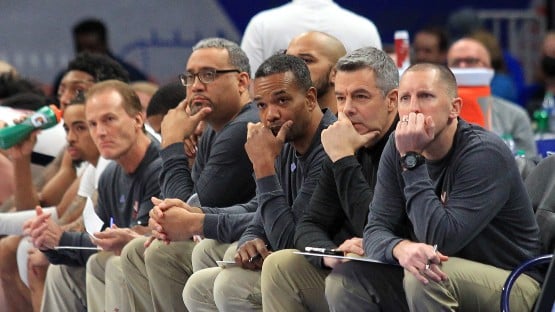
First, to the obvious, Democrats. The DLC wing of the Democratic Party is officially dead and buried now. Hillary Clinton sold her candidacy to voters in the primaries as the safe alternative in a tumultuous election year, as the scourge on the right represented by Donald Trump and Ted Cruz was poised to win the nomination on the Republican side.
Conventional wisdom on both sides of the political aisle has long held that the national parties need to run candidates on the national ticket who are as close to the middle of the spectrum as possible, with the lessons of Goldwater, McGovern and Mondale still relatively fresh in minds.
And then Clinton doubled down upon securing the nomination, partnering with another centrist, Virginia Sen. Tim Kaine, as her running mate, choosing not to balance out the ticket with fire, but rather with more ice.
Kaine barely registered a ripple on the national stage, serving at best as fourth fiddle among the campaign’s surrogates (behind both Obamas and Bill Clinton, arguably also trailing Elizabeth Warren and Bernie Sanders, who were massively underutilized).
The Clinton team further eroded its obvious advantage heading into the general by failing to articulate any sense of vision for what a Hillary Clinton presidency would mean for America.
Other than the fact that electing Clinton would make history by making her the first female president, what was the HRC team selling to voters?
That was the issue not only in 2016, but really, think back to 2008, when Clinton was the presumptive Democratic Party nominee, until a skinny guy from Illinois stole her thunder by energizing young voters with his promise of hope and change and rode that to the nomination and then the White House?
Clinton, ever the centrist, played ’08 as the inevitable candidate, until she wasn’t, and then made the same mistake in 2016, as Trump sold angry white voters on his own twisted version of hope and change.
The best we got from Clinton in the general was that she wasn’t Trump, and while, yes, the prospects of a Trump America are indeed scary, that fact alone wasn’t enough in the final analysis to motivate the Obama voters to come out in the same numbers as they had in 2008 and 2012.
To wit, at this writing, with a smattering of votes still to be counted nationwide, Trump was able to win the presidency not only while losing the popular vote this year, but also while falling 1.4 million votes short of what Mitt Romney got in 2012, when Romney lost to Obama by 5 million votes overall.
Yeah, wow, just, wow.
The safe route didn’t work for Democrats, as it didn’t work in 2004, when John Kerry’s team was famously said to be measuring the drapes in the Oval Office on Election Day based on the day’s early exit polling, as it didn’t work in 2000, when Al Gore also lost the election in the Electoral College despite winning the popular vote.
Too many Democrats live in New York and California, but we knew that already. You have to energize the voters in Florida, in North Carolina, in the Rust Belt, or you’re going to lose, bottom line.
Democrats are not going to make the same mistake in 2020, guaranteed. It’s a fair question to ask if Bernie Sanders would have fared better in a race against Trump. It’s semantics at this point to try to give a definitive answer on the result, but there’s no doubt that a Sanders candidacy would have energized the base in a way that Clinton wasn’t able to, twice.
Looking at 2020, then, you have to look at who can be that election cycle’s Sanders. It won’t be Sanders, who will turn 79 during that general, but it can be Elizabeth Warren, who quite a few thought should have been the running mate for Clinton this time around.
Warren is the highest-profile Democrat left standing after yesterday’s polling debacle, and absent the unexpected rise of a big-state Democratic governor in the next couple of years, she has to enter 2019 as the early favorite if she were to decide to run, and why wouldn’t she at this stage?
Turning our attention, then, to the Republican side, it’s not all milk and honey on the right, even with the party poised to control the White House and both houses of Congress for the first time in a decade. The reason: Trump ran as hard against Republicans as he did against Clinton and Democrats, and several high-profile Republican leaders cold-shouldered Trump to a point where you have to expect some sort of bloodletting between now and the inauguration.
It will be a surprise at this point to see Paul Ryan survive as House speaker, to cite one head likely to roll. The moderate wing of the party, headed up by guys like John McCain and Lindsey Graham, will get seats on the far edge of the big tent.
But the discord is likely to go both ways. Trump didn’t exactly sound all that Republican orthodox in his campaign, trashing the country-club business approach in his appeal to economic populism to win over the votes of disaffected workers in the Rust Belt, in particular.
The clock is already ticking on Trump with respect to 2020, too, and he will face the obvious challenge of the outsider candidate as he approaches re-election, that you can’t run for re-election again as the outsider candidate.
Warren, a frequent verbal sparring partner this year, will have the outsider bona fides that he won’t four years hence, so the pressure will be on Trump to deliver on promises to bring manufacturing jobs back to the U.S., to repeal and replace ObamaCare without interrupting healthcare insurance for the millions who now have access to it because of the Affordable Care Act, an interesting balancing act, there, if there ever was one.
Don’t assume that Republicans in Congress will automatically rubberstamp the Trump agenda, given the constituencies they have to answer to – namely, their campaign benefactors on Wall Street, the U.S. Chamber of Commerce and elsewhere in the business elite class.
Don’t assume, either, just because Clinton isn’t going to be president that we won’t have some sort of atmosphere of pending investigation hanging in the air over the Beltway. For all of Clinton’s issues with her private e-mail server, Trump is far from squeaky clean, with an obvious pressure point being the tax returns that he has pledged to release once his IRS audit is completed.
The fact that he didn’t release them before the election tells you that there are items in the returns that he didn’t want people to see. The thing we don’t know is if they were just things that could serve to embarrass him, or if there are indications of activity that may be of questionable legality.
Between that, and the numerous allegations that had surfaced in the final weeks of the campaign involving alleged assaults in the form of unwanted sexual touching of women, there are indications that the next four years could resemble the second Bill Clinton term in the late 1990s.
At this writing, we’re barely a day into the new world that few of us, on either side of the political divide, actually thought we would see happen.
Uncertainty abounds, indeed, but hey, at least we have plenty to talk about between now and Jan. 20.
Column by Chris Graham










